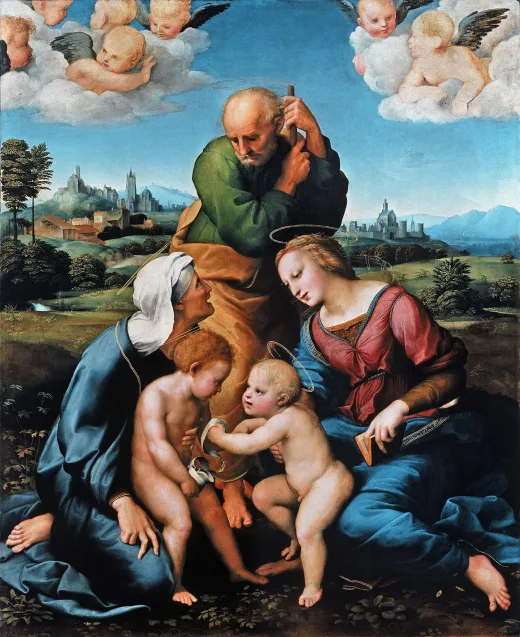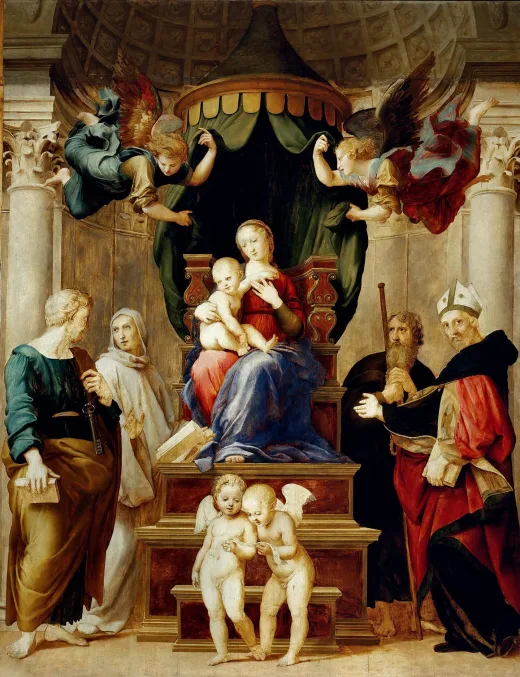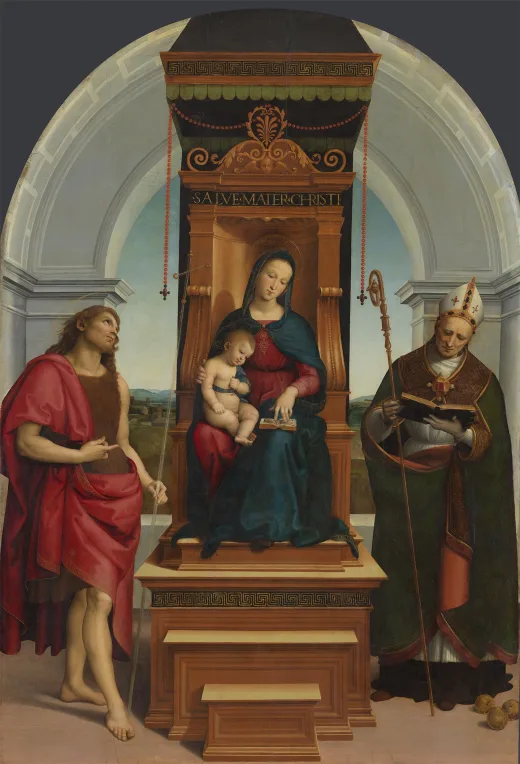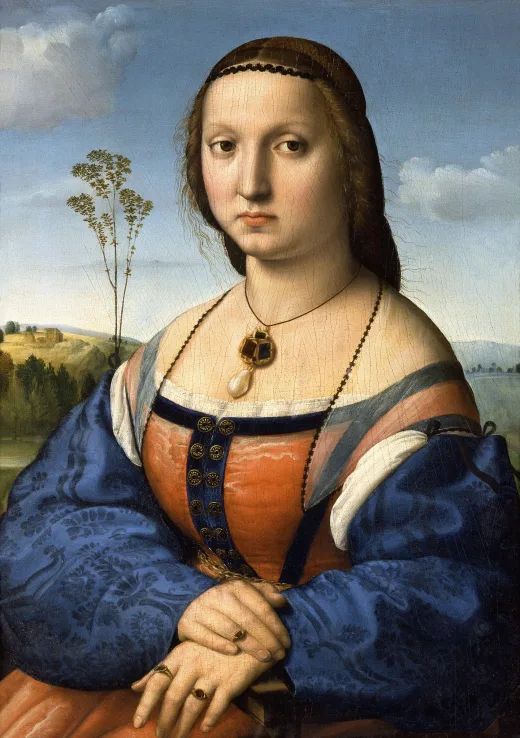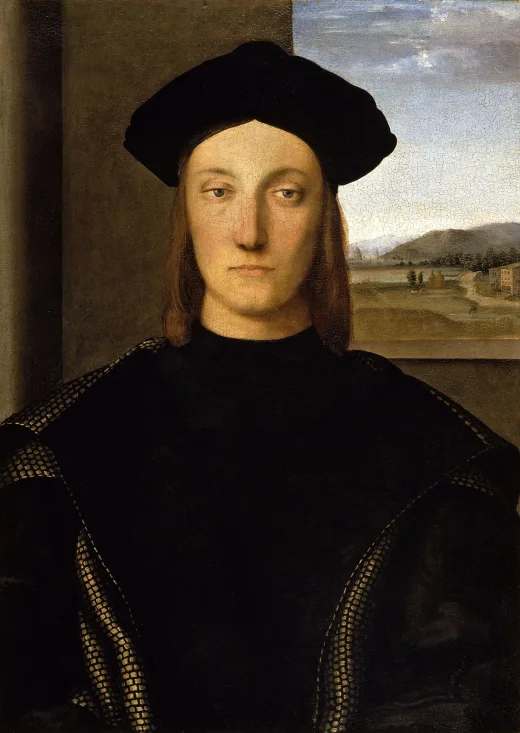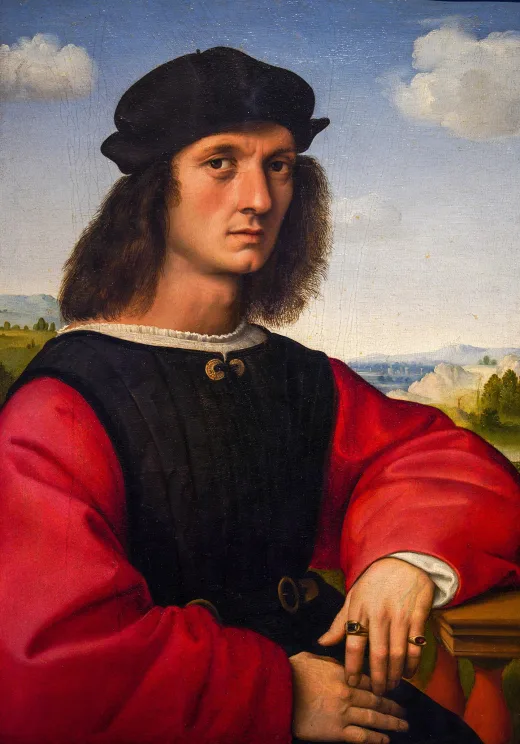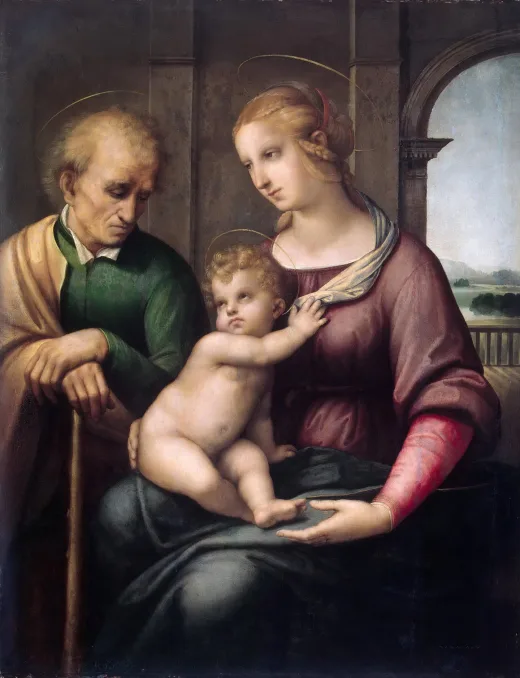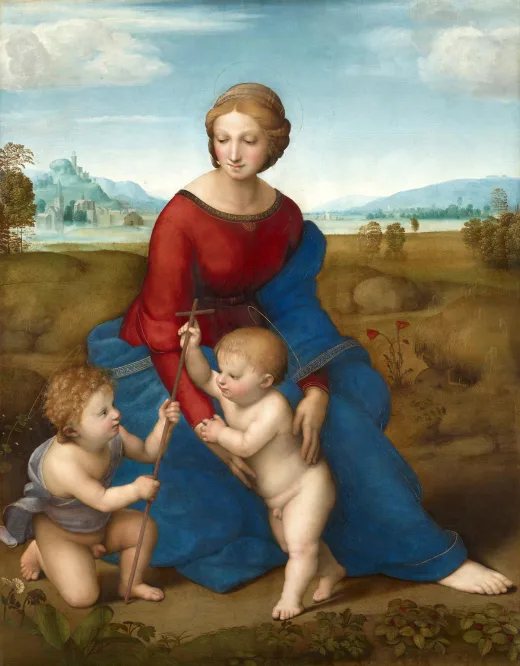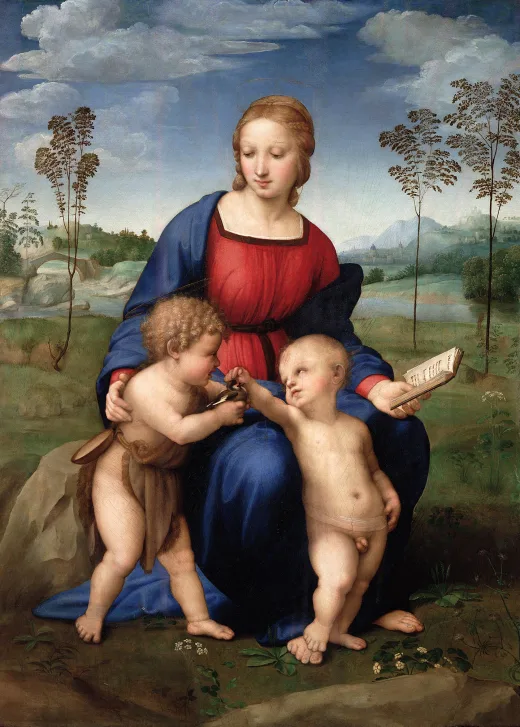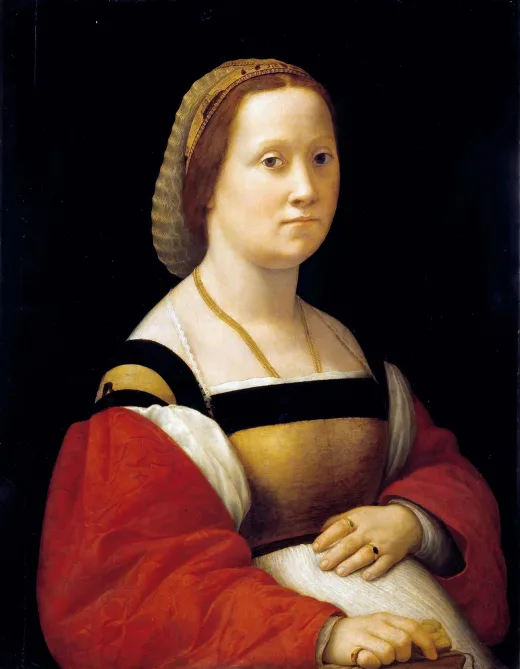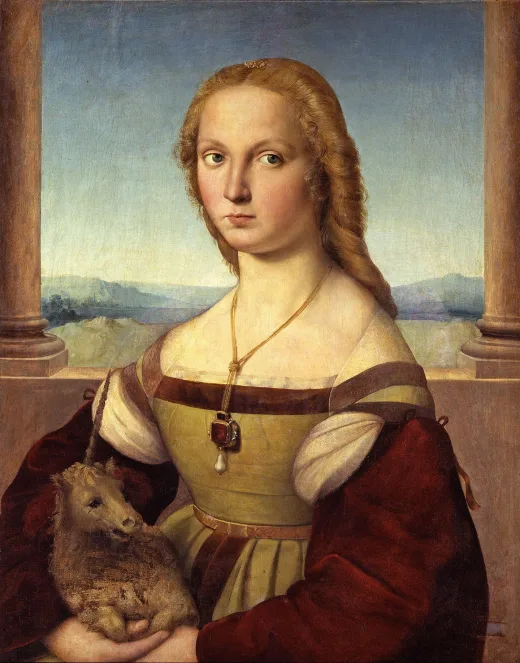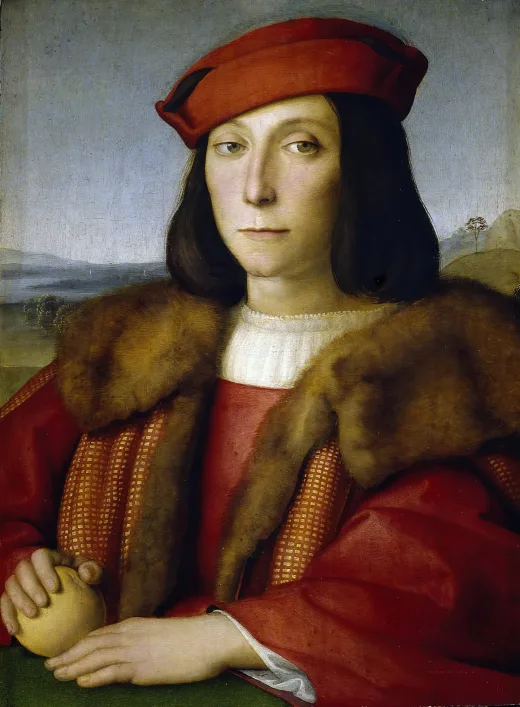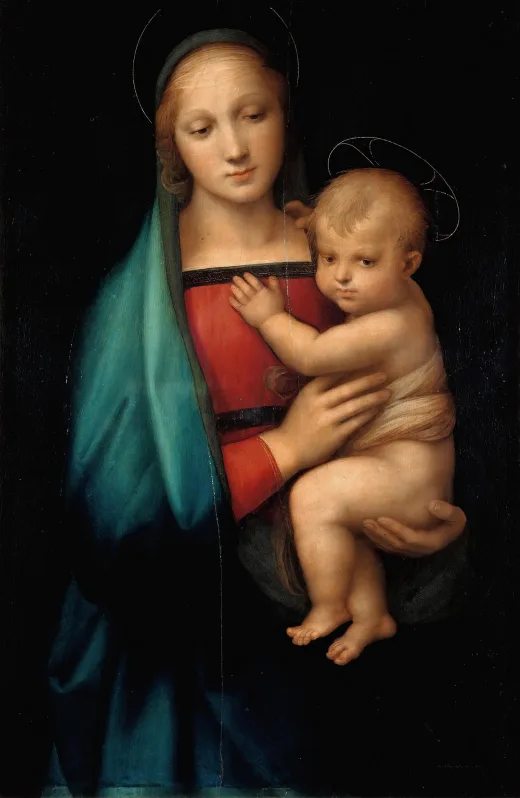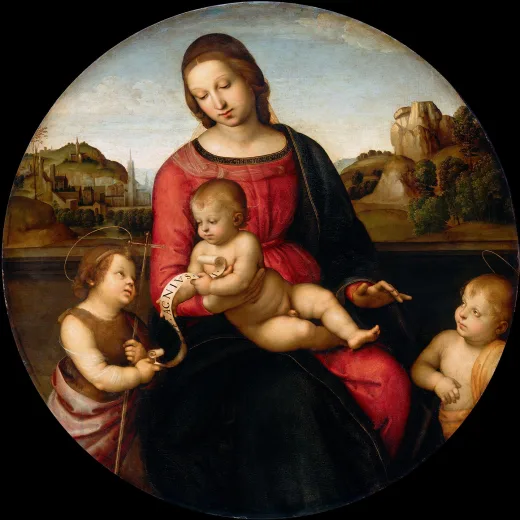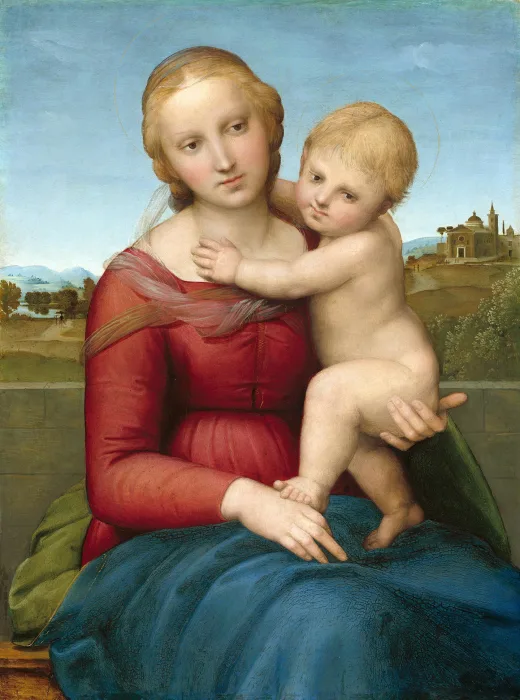拉斐尔作品《花园中的圣母》又名《圣母子与施洗者圣约翰》高清图片
原图尺寸:6880×10699像素(72 DPI)高清图
下载原图消耗3艺点
文件大小:30.24 MB
下载格式: JPG / ZIP
作品名称:花园中的圣母(圣母子与施洗者圣约翰)
La Belle Jardinière(Madonna and Child with Saint John the Baptist)
作品作者:拉斐尔(由“里多尔福·德尔·基尔兰达约”完成)
创作时间:约1507-1508年
作品风格:文艺复兴盛期
原作尺寸:122×80 厘米
收藏位置:巴黎卢浮宫
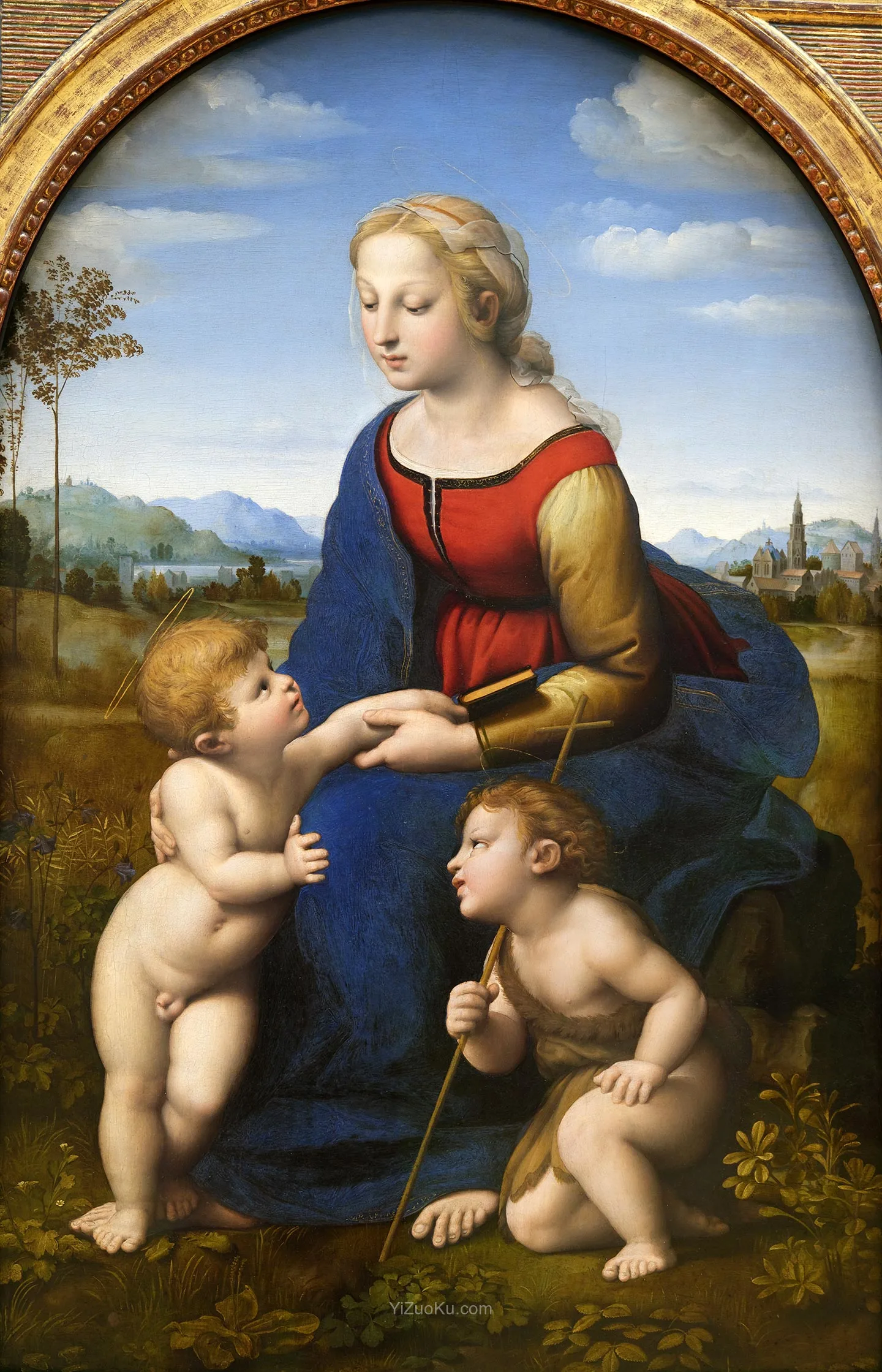
作品简介
《花园中的圣母》,又称《圣母子与施洗者圣约翰》,是意大利文艺复兴盛期画家拉斐尔开始创作、里多尔福·德尔·吉兰达约完成的一幅画作,描绘了圣母、幼年基督和幼年施洗者圣约翰的形象。据信这幅画约在 1507 年由锡耶纳贵族法布里齐奥·塞尔加迪委托创作。目前它陈列在法国巴黎的卢浮宫博物馆。
这幅画描绘了圣母、基督和幼年施洗者圣约翰。圣母是画面的焦点。她的脸位于金字塔式构图的顶端,身体占据了画面的大部分其余空间。她抱着站在她右脚边的圣婴基督。施洗者圣约翰在圣母左边的地上,右手拿着他的芦苇十字架。圣母放在腿上的那只手拿着一本书。他们所有人的头顶都有淡淡的光环,这一特征在文艺复兴盛期逐渐消失。画面的背景是一片美丽的乡村花园景色。拉斐尔运用了统一的自然主义构图,色彩丰富而明亮,巧妙地融合了光影,营造出了高度逼真的氛围。
这幅画被认为是意大利文艺复兴画家拉斐尔最著名的圣母像之一。许多艺术史学家认为,这幅画是拉斐尔艺术成就的巅峰之作,也是他佛罗伦萨时期最杰出的作品之一。拉斐尔在完成《金翅雀圣母》后开始创作《花园中的圣母》。这幅作品也与他的下一幅作品《草地上的圣母》相互呼应。
拉斐尔在离开佛罗伦萨之前未能完成这幅画,后来由里多尔福·德尔·吉兰达约完成。吉兰达约尤其因完成了圣母的蓝色长袍而受到赞誉。这幅画后来被法国国王弗朗索瓦一世带到巴黎,在那里广受欢迎,还被许多其他艺术家临摹。
这幅画的一个显著特征是圣母。她是画面的核心。她用一只手臂保护性地搂着基督,基督站在她的一只脚上抬头看着她,展现出一种依赖和孩子般的信任。在另一边,施洗者圣约翰跪着,手中拿着作品中出现的两个宗教象征物之一。拉斐尔摒弃了以往在一幅作品中放置多个宗教象征物的做法。相反,他将宗教图像与美丽的风景相结合,既展现了人文主义,又传达了天主教会的教义。另一个宗教象征是淡淡的光环,这种特征在艺术家进入文艺复兴盛期后逐渐消失。人们认为圣母手中拿着的书包含了对基督死亡的预言。拉斐尔的构图方式营造出了圣母与基督之间的亲密感,施洗者圣约翰则作为见证者。圣母和基督的姿势,在较小程度上还有施洗者圣约翰的姿势,预示了基督的受难和最终死亡。圣母手中的书讲述了这些最终的事件。
拉斐尔在佛罗伦萨时研究了列奥纳多·达·芬奇、米开朗基罗·博那罗蒂和弗拉·巴托洛梅奥的作品。他摒弃了自己翁布里亚时期流行的生硬构图,转而采用受这些艺术家影响的新风格。这幅《花园中的圣母》尤其明显借鉴了达·芬奇的典范之作,如《圣母子与圣安妮》。
这幅画呼应了彼得罗·佩鲁吉诺作品中开阔的风景。拉斐尔还运用了文艺复兴盛期艺术中常见的金字塔式构图以及晕涂法。《花园中的圣母》的另一个特点是圣母那高度理想化的美丽与优雅。尽管受到其他艺术家的启发,但拉斐尔能够超越对他人作品的简单再现,融入自己的风格,使自己的作品更上一层楼。
La Belle Jardinière, also known as the Madonna and Child with Saint John the Baptist, is a painting started by the Italian High Renaissance artist Raphael, and finished by Ridolfo del Ghirlandaio, that depicts the Madonna, a young Christ, and a young John the Baptist. It is believed to have been commissioned by the Sienese patrician Fabrizio Sergardi in approximately 1507. It is currently displayed in the Louvre Museum in Paris, France.
The painting portrays Mary, Christ and a young John the Baptist. Mary is the focus of the painting. Her face is situated at the apex of the pyramidal composition and her body fills most of the rest. She is holding the Christ child, who is standing at her foot to her right. John the Baptist is on the ground to the left of Mary and is holding his reed cross with his right hand. Mary is holding a book in the hand that is resting on her lap. There are faint halos around all of their heads, a feature that disappears in the High Renaissance. The landscape of the painting is that of a beautiful countryside garden. Raphael used a unified naturalistic composition with rich and luminous colors and blended light and shadows to help create a highly realistic atmosphere.
This painting is considered one of the most famous Madonna portraits of Italian Renaissance painter, Raphael. Many art historians believe that this painting is the peak of Raphael's achievements and one of his strongest pieces from his Florentine phase. Raphael began to paint La Belle Jardinière after finishing Madonna of the Goldfinch. This work also mirror his next piece Madonna of the Meadow.
Raphael was unable to complete this painting before he left Florence. It was later finished by Ridolfo del Ghirlandaio. Ghirlandaio is especially credited for completing the blue robe of Mary. The painting was later taken to Paris by King Francis I of France, where it gained in popularity and was copied by many other artists.
One of this painting's defining features is the Madonna. She is the focus of the painting. She has a protective arm around Christ as he looks up at her while standing on one of her feet, showing a sense of dependency and childlike trust. On the other side kneels John the Baptist holding one of the two religious symbols seen in the work. Raphael diverged from the previous practice of placing multiple religious symbols in a piece. Instead he combines religious iconography and beautiful landscapes to show both humanism and the teaching of the Catholic Church. The other religious symbol seen is the faint halos that disappeared as artists entered the High Renaissance. The book that the Madonna is holding is believed to contain the foretelling of Christ's death. The way Raphael composed the painting creates a sense of intimacy between Mary and Christ, with John the Baptist as witness. The positions of Mary and Christ, and to a lesser extent John the Baptist, serve as a prefiguration of the Passion and eventual death of Christ. The book Mary hold tells of these eventual events.
Raphael studied the works of Leonardo da Vinci, Michelangelo Buonarroti, and Fra Bartolommeo while in Florence. He traded his use of stiff compositions that were popular during his Umbrian phase in favor of a newer style influenced by his study of these other artist. This painting in particular appears to be derived from Leonardo's models, such as The Virgin and Child with Saint Anne.
The painting echoes the spacious landscapes of Pietro Perugino. He also utilized the popular pyramid composition common with art in the High Renaissance as well as the sfumato technique. Another feature seen in La Belle Jardinière is the highly idealized beauty and grace of the Madonna. Despite taking inspiration from other artist, Raphael was able to move past just recreating others works and add his own styles to benefit his works.
